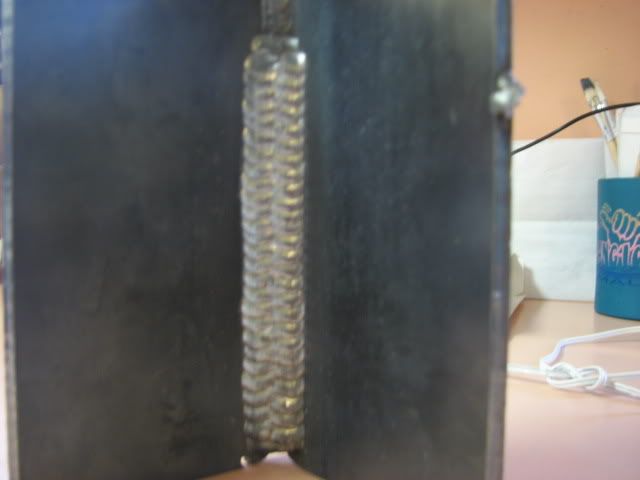You are using an out of date browser. It may not display this or other websites correctly.
You should upgrade or use an alternative browser.
You should upgrade or use an alternative browser.
lets see some welds.
- Thread starter Jeep80CJ7
- Start date
- Status
- Not open for further replies.
Tacoma
Et incurventur ante non
- Location
- far enough away
What's the point of the triple pass? That material doesn't look thick enough to warrant that?
What's the point of the triple pass? That material doesn't look thick enough to warrant that?
well i did it for practice. in my first post it said on scrap metal.
Tacoma
Et incurventur ante non
- Location
- far enough away
Ok, well congratulations. Looks like a nice pile of filler. ???
Tacoma
Et incurventur ante non
- Location
- far enough away
After years of practice, here's the best I could come up with. :-\
lol i hear ya, I can weld but never looks that pretty
LT.
Well-Known Member
- Location
- Los Alamos, New Mexico
lol i hear ya, I can weld but never looks that pretty
Yeah, me too. I have found that if I need something welded I ask someone who knows what they are doing. When I weld it ain't purdy. It kind of looks like some sneezed on the metal when I get finished with it.
LT.
post up your best welds. Heres one i did at work on some scrap metal. three pass vertical up. cooled in water after each pass to componsate for material thickness.
Explain how you created these welds. What techniques and such.
Depends on the temperature it was brought to. If my memory is correct-quenching steel can bring it into the martensite phase which actually makes it softer. Its better to cool it faster than the air will cool it however not so fast as to put it in the wrong phase.
richpblaze
Registered User
- Location
- Stansbury Park, Utah
Yeah This guy seems like a TOOL
If you have seen his comments on pirate.
If you have seen his comments on pirate.
Corban_White
Well-Known Member
- Location
- Payson, AZ
Depends on the temperature it was brought to. If my memory is correct-quenching steel can bring it into the martensite phase which actually makes it softer. Its better to cool it faster than the air will cool it however not so fast as to put it in the wrong phase.
If steel is brought to ~1500*F (give or take depending on the carbon content) and quickly quenched (in oil or water) it becomes martensite. Above that temp steel changes the cubic structure which allows more of the carbon in the steel to dissolve into the iron structure. makes the steel very very hard but also very brittle. Martensite is the hardest phase of steel and also the most brittle. In order to heat treat steel, it is first turned into martensite and then heated to a certain temp. (depending on the hardness/brittleness ratio desired) and allowed to slowly cool. Since welding occurs at above 3000*F if the piece was quenched while it was still above 1300-1600*F it would have become martensite and would be very brittle (but also very hard). Generally it is a bad idea to quench after welding.
Kiel
Formerly WJ ZUK
If you have seen his comments on pirate.
James K
NO, I'm always like this
- Location
- Taylorsville, Ut
you're a tool. stop trolling for a cookie.your cute
wanna impress someone? then show us something you built otherwise you're a tool!
UNSTUCK
But stuck more often.
I have never met a great welder or a great mechanic that thinks they are.
If you ask a old hand, they will tell you that they dont know what they are doing. When in reality they may be one of the best.
^^^Wow, that reads like crap^^^
I like those guys. Hope to be one some day.
Explain how you created these welds. What techniques and such.
Well my first pass i did a triangle pattern. burning straight into the root right above my two paused stops which created my puddles. then instantly straight back down pausing on each side making sure i have more time on the sides then the center to keep it flat. Second and third pass are just the z weave pattern. each pass I made sure my weld only went half way past the previous weld on each side. Not sure if that is a good explanation, but the best I could do.
And I only quenched the pieces of metal to make up for the size of the material. like I was taught in school. Doing a three pass weld like that without cooling on such thin material would make it way to hot by about the second pass and make the puddle hard to control. When doing this on thicker materials like it's meant to be done on i know and understand you would not quench it. bad idea.
- Status
- Not open for further replies.




